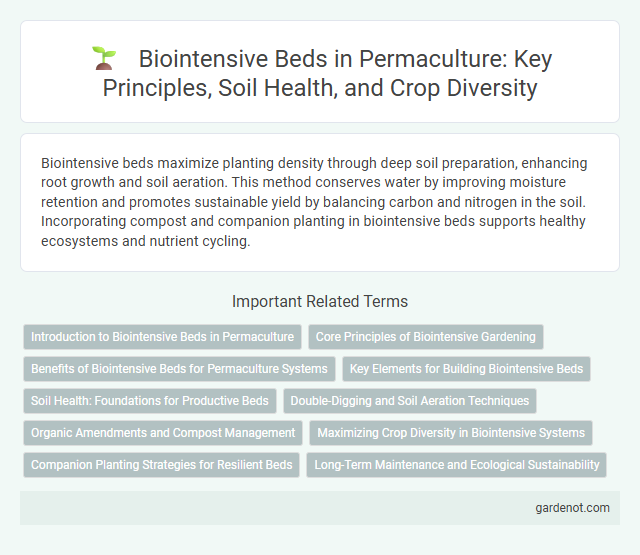Biointensive beds maximize planting density through deep soil preparation, enhancing root growth and soil aeration. This method conserves water by improving moisture retention and promotes sustainable yield by balancing carbon and nitrogen in the soil. Incorporating compost and companion planting in biointensive beds supports healthy ecosystems and nutrient cycling.
Introduction to Biointensive Beds in Permaculture
Biointensive beds in permaculture maximize soil fertility and crop yields by concentrating organic matter and nutrients in a small area, promoting deep soil aeration and enhanced root growth. This method utilizes double-dug beds filled with compost and rich soil amendments to improve water retention and microbial activity. Incorporating biointensive techniques supports sustainable, high-density food production while preserving soil health and biodiversity.
Core Principles of Biointensive Gardening
Biointensive gardening emphasizes deep soil cultivation to maximize aeration and water retention, promoting vigorous root growth and higher yields. It prioritizes close plant spacing to create a microclimate that conserves moisture and suppresses weeds, enhancing overall garden productivity. Crop diversity and companion planting are central to maintaining soil fertility and reducing pest pressure naturally.
Benefits of Biointensive Beds for Permaculture Systems
Biointensive beds maximize soil fertility and water retention by using deep soil preparation and close plant spacing, which enhances nutrient cycling in permaculture systems. These beds promote higher yields per square foot while minimizing external inputs, supporting sustainable food production. Their carbon-sequestering potential improves soil health and resilience, contributing to long-term ecosystem stability.
Key Elements for Building Biointensive Beds
Biointensive beds require deep, aerated soil enriched with compost to maximize nutrient availability and water retention. Focus on achieving optimal soil structure through double digging techniques and incorporating carbon-rich materials like mulch for balanced fertility. Plant spacing should ensure maximal light exposure and air circulation to promote healthy root systems and efficient resource use.
Soil Health: Foundations for Productive Beds
Biointensive beds prioritize soil health by maximizing organic matter, enhancing microbial activity, and maintaining optimal moisture retention for robust plant growth. Techniques such as double digging and incorporating compost improve soil aeration and nutrient availability, creating a fertile environment for deep-rooted crops. This foundation supports sustainable productivity and resilience, ensuring long-term soil vitality in permaculture systems.
Double-Digging and Soil Aeration Techniques
Biointensive beds utilize double-digging to enhance soil structure and root penetration by manually loosening two layers of soil, which improves aeration and water infiltration. This technique increases oxygen availability to plant roots, promoting robust microbial activity essential for nutrient cycling and healthy plant growth. Regular soil aeration in biointensive beds prevents compaction, supports organic matter integration, and optimizes water retention for sustainable permaculture gardening.
Organic Amendments and Compost Management
Biointensive beds rely heavily on organic amendments such as well-aged compost, vermicompost, and green manures to enrich soil fertility and structure. Effective compost management involves maintaining optimal moisture, aeration, and temperature to accelerate decomposition and maximize nutrient availability for plants. Incorporating diverse organic inputs enhances microbial activity, improves soil water retention, and supports sustainable nutrient cycling in permaculture systems.
Maximizing Crop Diversity in Biointensive Systems
Biointensive beds maximize crop diversity by integrating companion planting and staggered sowing techniques, which enhance soil fertility and pest resistance naturally. This system supports multiple crop layers, including deep-rooted, shallow-rooted, and foliar plants, optimizing space and resource use within a single bed. Diverse crop selection improves yields per square foot while promoting ecological balance and resilience against environmental stresses.
Companion Planting Strategies for Resilient Beds
Biointensive beds use companion planting strategies to enhance soil fertility, pest control, and crop yields by pairing complementary plant species. Deep-rooted plants improve soil aeration, while nitrogen-fixing legumes enrich soil nutrients, creating resilient, self-sustaining ecosystems. Strategic plant diversity in biointensive beds maximizes space and strengthens plant health against environmental stresses and pests.
Long-Term Maintenance and Ecological Sustainability
Biointensive beds emphasize deep soil preparation and organic matter incorporation to enhance long-term soil fertility and structure. Maintaining these beds requires regular compost application, crop rotation, and carbon farming techniques to support microbial life and nutrient cycling. This sustainable approach reduces water usage, minimizes external inputs, and promotes resilient ecosystems within permaculture designs.
Biointensive bed Infographic

 gardenot.com
gardenot.com